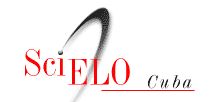Etiopatogenia de la microangiopatía diabética. Consideraciones bioquímicas y moleculares
Resumen
Palabras clave
Referencias
Organización Mundial de la Salud. Diabetes[Internet]. Ginebra:Organización Mundial de la Salud;2013[citado 13 Abr 2013]. Disponible en: http://www.who.int/mediacentre/factsheets/fs312/es/index.html.
Ministerio de Salud Pública. Anuario Estadístico de Salud 2011[Internet]. La Habana:Dirección Nacional de Estadísticas;2011[citado Sep 2012]. Disponible en: http://www.sld.cu/sitios/dne.
Ministerio de Salud Pública. Anuario Estadístico de Salud 2012[Internet]. La Habana:Dirección Nacional de Estadísticas;2012[citado Sep 2013]. Disponible en: http://www.sld.cu/sitios/dne.
Triana ME. La hiperglicemia y sus efectos tóxicos. Un concepto patogénico para la micro y macroangiopatía diabética. Rev Cubana Angiol y Cir Vasc. 2001;2(2):131-41.
Maitra AK, Abbas A. El sistema endocrino. En:Robins y Cotran. Patología Estructural y Funcional. 7ma ed. Madrid:Elsevier SA;2005. p. 1201–9.
Santos VP, Caffaro RA, Pozzan G, Saieg MA, Castelli V. Comparative histological study of artherosclerotic lesions and microvascular changes in amputed lower mibs of diabetic and non-diabetic aptients. Arq Bras Endocrinol Metabol. 2008;52(7):1115-23.
Kramer Ck, Leitao CB, Pinto LC, Bolson P, Boza J, Silveiro SP, et al. Risk factors for micro and macrovascular disease in black and white patients with type 2 Diabetes mellitus. Rev Assoc Med Bras. 2009;55(3):308-14.
Figuerola D, Reynals E. Diabetes mellitus. En: Farreras Valentí P, Rozman C. Medicina Interna. 13ra ed. Madrid:Mosbi;1995. p. 1933-68.
The Diabetes Control and Complications Trial Research Group. The effect of intensive treatment of diabetes on the development and progression of long-term complications in insulin dependent diabetes mellitus. N Engl J Med. 1993;329(14):977-86.
UK Prospective Diabetes Study (UKPDS) Group. Intensive blood-glucose control with sulphonylureas or insulin compared with conventional treatments and risk of complications in patients with type 2 diabetes (UKPDS 33). Lancet. 1998;352(9131):837-53.
Villanueva V. Enfoque práctico de las complicaciones crónicas de la Diabetes Mellitus. Rev Pos Via Cát Med. 2003;1(130):1-18.
Mahía M, Pérez L. La diabetes mellitus y sus complicaciones vasculares:un problema social de salud. Rev Cubana Angiol y Cir Vasc. 2000;1(1):68-73.
Corrêa ML, Vieira SM. A predisposiçao genética para o desenvolvimento da microangiopatia no DM1. Arq Bras Endocrinol Metab. 2008;52(2):375-86.
Emanueli C, Salis MB, Pinna A, Stacca T, Milia AF, Spano A, et al. Prevention of diabetes-induced microangiopathy by human tissue kallikrein gene transfer. Circulation. 2002;106(8):993–9.
Cardellá L, Hernández R. Estructura y función de las biomoléculas. Bioquímica Médica. La Habana:ECIMED;1999. p. 105–12.
Olmos P, Araya-Del-Pino A, González C, Laso P, Irribarra V, Rubio L. Fisiopatología de la retinopatía y nefropatía diabéticas. Rev méd Chile. 2009;137(10):1375–84.
Cardellá L, Hernández R. Digestión y absorción de los glúcidos. Bioquímica Médica. La Habana:ECIMED; 1999. p. 715.
Das Evcimen ND, King GL. The role of protein kinase C activation and the vascular complications of diabetes. Pharmacol Res. 2007;55(6):498-510.
Lavrentyev EN, Malik KU. High glucose-induced Nox1-derived superoxides downregulate PKC-βII, which subsequently decreases ACE2 expression and ANG(1-7) formation in rat VSMCs. Am J Physiol Heart Circ Physiol. 2009;296(1):H106–18.
Sutera SP, Chang K, Marvel J, Williamson JR. Concurrent increases in regional hematocrit and blood flow in diabetic rats:prevention by sorbinil. Am J Physiol Heart Circ Physiol. 1992;263(3 Pt 2):H945-50.
González R, Buchaca E, Licea ME. Fisiopatología y progresión de las personas con prediabetes. Rev Cubana Endocrinol. 2011;22(1):1-7.
Cruz J, Licea ME. Glucosilación no enzimática y complicaciones crónicas de la diabetes mellitus. Rev Cubana Endocrinol. 2010;21(2):223-55.
Janghorbani M, Amini M. Patterns and predictors of long-term glycemic control in patients with type 2 diabetes. Endocrinol. 2012:526824. doi: 10.5402/2012/526824.
Jakus V, Rietbrock N. Advanced glycation end-products and the progress of diabetic vascular complications. Physiol Res. 2004;53(2):131-42.
Guo X, Wang L, Chen B, Li Q, Wang J, Zhao M, et al. ERM protein moesin is phosphorylated by advanced glycation end products and modulates endothelial permeability. Am J Physiol Heart Circ Physiol. 2009;297(1):H238-46.
Bagi Z, Toth E, Koller A, Kaley G. Microvascular dysfunction after transient high glucose is caused by superoxide-dependent reduction in the bioavailability of NO and BH(4). Am J Physiol Heart Circ Physiol. 2004;287(2):H626-33.
Bishara NB, Ding H. Glucose enhances expression of TRPC1 and calcium entry in endothelial cells. Am J Physiol Heart Circ Physiol. 2010;298(1):H171-8.
Abi-Chahin TC, Hausen Mde A, Mansano CM, Halfoun VL. Microvascular reactivity in type 1 diabetics. Arq Bras Endocrinol Metabol. 2009;53(6):741–6.
Houben AJ, Schaper NC, Haan CH, Huvers FC, Slaaf DW, Leeuw PW, et al. Local 24-h hyperglycemia does not affect endothelium-dependent or -independent vasoreactivity in humans. Am J Physiol. 1996;270(6 Pt 2):H2014-20.
Padilla DJ, McDonough P, Behnke BJ, Kano Y, Hageman KS, Musch TI, et al. Effects of Type II diabetes on capillary hemodynamics in skeletal muscle. Am J Physiol Heart Circ Physiol. 2006;291(5):H2439-44.
Álvarez N. Retinopatía Diabética. Bol Esc Med. 2006;31(2):1-90.
Lee IG, Chae SL, Kim JC. Involvement of circulating endothelial progenitor cells and vasculogenic factors in the pathogenesis of diabetic retinopathy. Eye. 2006;20(5):546–52.
Fadini GP, Mancuso P, Bertolini F, de Kreutzenberg S, Avogaro A. Amelioration of Glucose Control Mobilizes Circulating Pericyte Progenitor Cells in Type 2 Diabetic Patients with Microangiopathy. Exp Diab Res. 2012;12(1):1–8.
Macía Heras M, Macía Jerez M, Coronel F. Nefropatía diabética:fisiopatología y curso clínico. Nefrología. 2001;21(3):1-10.
Enlaces refback
- No hay ningún enlace refback.
FINLAY EN: 








FINLAY CERTIFICADA POR:

Esta revista "no aplica" cargos por publicación en ninguna etapa del proceso editorial.
Dirección postal: Calle 51A y Avenida 5 de Septiembre Cienfuegos, Cuba Código postal: 55100.
http://www.revfinlay.sld.cu
Telefono: +53 43 516602. Telefax: +53 43 517733.
amgiraldoni@infomed.sld.cu
ISSN: 2221-2434
RNPS: 5129






